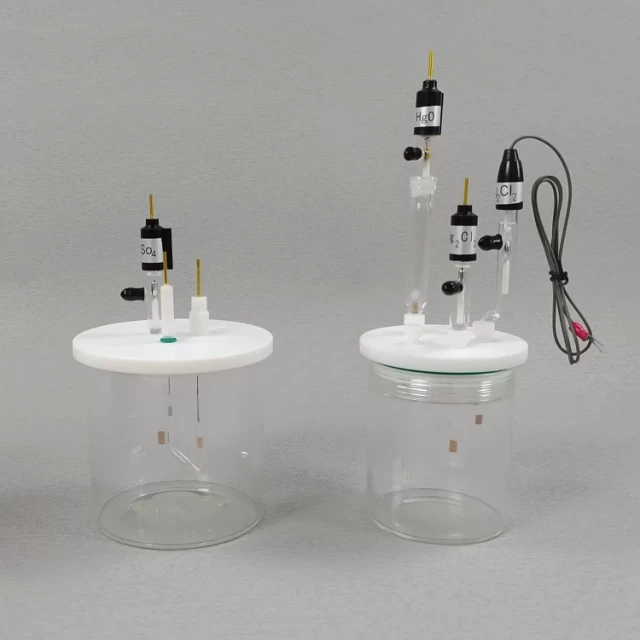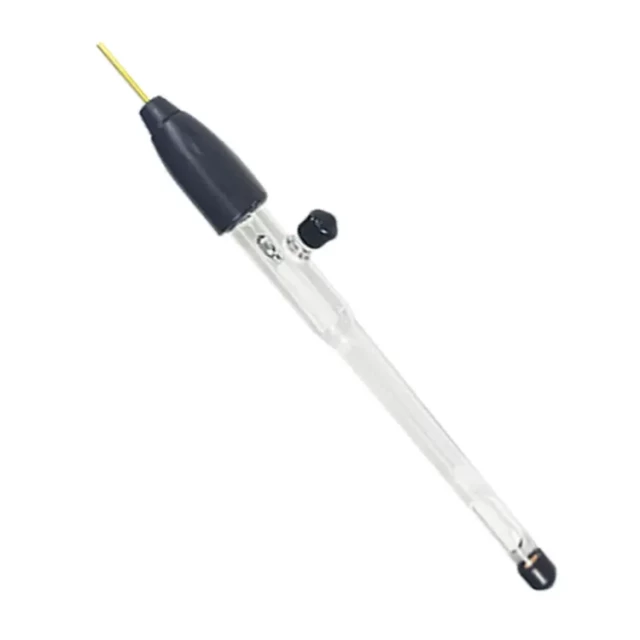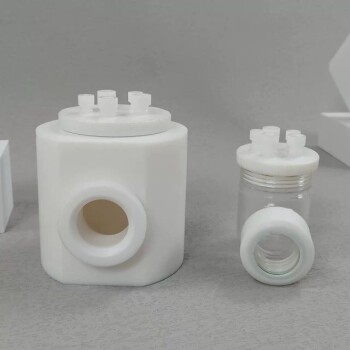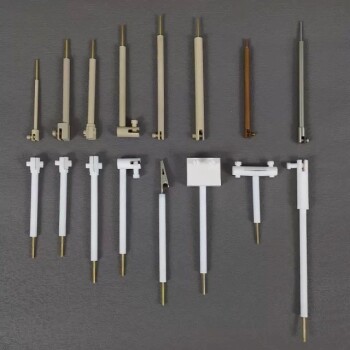Introduction to Reference Electrodes
A reference electrode is an electrode with a stable and well-defined potential that is used as a reference point to measure the potential of other electrodes. Reference electrodes are commonly used in electrochemical experiments to determine the potential difference between two electrodes. There are various types of reference electrodes available, including aqueous and non-aqueous reference electrodes. Aqueous reference electrodes are used in aqueous solutions, and non-aqueous reference electrodes are used in non-aqueous solutions. One of the most commonly used reference electrodes is the Ag/AgCl reference electrode, which is simple to make and has a stable potential.
Table of Contents
Types of Reference Electrodes
There are various types of reference electrodes available for electrochemical experiments. Understanding the differences between these electrodes is critical to ensure accurate measurements.

Aqueous Reference Electrodes
Aqueous reference electrodes are commonly used and include the following types:
- Standard hydrogen electrode
- Normal hydrogen electrode
- Saturated calomel electrode
- Reversible hydrogen electrode
- Silver chloride electrode
- Copper-copper sulfate electrode
- PH electrode
- Dynamic hydrogen electrode
- Palladium-hydrogen electrode
Non-Aqueous Reference Electrodes
For non-aqueous electrochemical experiments, a reference electrode can be easily made from commercially available (or recycled) glass reference electrode compartments, vycor frits, and silver wire. The most common non-aqueous reference electrode is the quasi-reference electrode, which is made fresh for any given experiment. Pseudo-reference electrodes do not maintain their potentials. For one to use this type of reference electrode, affecting conditions must be known and calculated.
Own-Constructing Reference Electrodes
Making your own reference electrode is a cost-effective solution. One of the most commonly used types is the silver/silver chloride electrode, which can be easily fabricated using a silver wire and a solution of sodium chloride. Another option is the saturated calomel electrode, which requires the use of mercury, potassium chloride, and hydrochloric acid. A third type, the Ag/AgBr electrode, can be made by coating a silver wire with silver bromide in the presence of sunlight.
Commercially Available Reference Electrodes
Lastly, there are commercially available reference electrodes that advertise themselves as “no-leak” which are suitable for many non-aqueous applications. Users should test these under their particular cell conditions before accepting them for routine use. They should also be aware that many of the materials which constitute the body of the reference electrode may not hold up well in the solvent of choice.
By understanding the various types of reference electrodes available, one can make an informed decision as to which reference electrode type is right for their application. Regardless of the type of reference electrode used, it is important to ensure that it is properly calibrated before use to ensure accurate measurements. Additionally, it is important to note that reference electrodes can degrade over time and may need to be replaced periodically to maintain accuracy.
Aqueous Reference Electrodes
For scientists and researchers working in the field of electrochemistry, reference electrodes are essential tools for accurate measurements and reliable data. A reference electrode is an electrode that has a stable and well-known electrode potential. The overall chemical reaction taking place in a cell is made up of two independent half-reactions, which describe chemical changes at the two electrodes. To focus on the reaction at the working electrode, the reference electrode is standardized with constant (buffered or saturated) concentrations of each participant of the redox reaction.
Aqueous reference electrodes are widely used for electrochemical experiments. Common reference electrodes include the Standard Hydrogen Electrode (SHE), Normal Hydrogen Electrode (NHE), Reversible Hydrogen Electrode (RHE), Saturated Calomel Electrode (SCE), Copper-Copper(II) Sulfate Electrode (CSE), Silver Chloride Electrode, pH-electrode, Palladium-hydrogen electrode, Dynamic hydrogen electrode (DHE), and Mercury-mercurous sulfate electrode (MSE).
Silver Chloride Electrode
An Ag/AgCl reference electrode is the most commonly used reference in electrochemical analysis. It consists of a silver wire with a silver chloride dip, surrounded by a salt electrolyte (this can be a solution or gel). The salt is usually potassium chloride (KCl), which has been saturated in silver chloride to ensure the silver chloride dip does not become stripped. In order for a reference electrode to work, a small amount of the internal fill solution will leak from the sensor to the sample, which provides electrical contact and a stable, unchanging potential. This leak path is through the electrode junction, which can be made from a range of materials including ceramic, cotton, Teflon, and more.
Ag/AgCl Reference Electrode Working Principle
This electrode is based on the following half-cell reaction: AgCl + e- <->Ag+ + Cl-. An Ag/AgCl reference electrode provides 199mV (±5mV) versus a normal hydrogen electrode if surrounded by saturated KCl/AgCl solution measured at 25°C. Hydrogen electrodes are used as more of a theoretical standard than used practically across laboratories, therefore reference electrodes are often checked against other electrodes with the same reference system, or against other references with known potentials for which data is available.
How to Make Your Own Aqueous Reference Electrode
While commercial reference electrodes are readily available, making your own aqueous reference electrode can be a cost-effective and rewarding experience. To make your own reference electrode, you will need a few basic materials, including a silver wire or rod, an Ag/AgCl wire, a glass tube, and a salt bridge. The first step is to prepare the silver wire by cleaning it with acid and polishing it using a polishing cloth or pad. Next, insert the silver wire into the glass tube, leaving a small portion exposed. Then, attach the Ag/AgCl wire to the exposed portion of the silver wire using a silver epoxy or conductive adhesive. Finally, fill the glass tube with a KCl solution and connect the salt bridge to the Ag/AgCl wire. Your homemade aqueous reference electrode is now ready to use in your electrochemical experiments.
Features and Considerations for Selecting a Reference Electrode
When selecting a reference electrode, it is important to consider several factors, including compatibility with the sample being measured, stability of potential, response time, temperature range, and chemical composition of the sample. There are several options available for reference electrodes, including separate reference electrodes such as Saturated Calomel (Hg/HgCl), Ag/AgCl, Cu/CuSO4, Hg/HgSO4, and Hg/HgO. Double junction electrodes have a lower chamber that contains an electrolyte that differs from the electrolyte in the top reference chamber. This allows for customizing the chemical composition of the lower chamber electrolyte to match the sample.
Non-Aqueous Reference Electrodes
In electrochemical experiments, reference electrodes are essential as they provide a stable and reliable potential against which other electrodes can be measured. Commercial reference electrodes are readily available, but in some cases, it is also possible to make your own non-aqueous reference electrode using simple materials.
Issues with Aqueous Reference Electrodes
While the saturated calomel electrode (SCE) and the Ag/AgCl reference electrodes are stable and offer constant half-cell potentials, they are aqueous electrodes based around saturated aqueous solutions. It is not advisable to use these aqueous reference electrodes with non-aqueous systems as the potentials measured in different solvents are not directly comparable. Moreover, the potential for the Fc0/+ couple is sensitive to solvent.
Quasi-Reference Electrode (QRE)
A quasi-reference electrode (QRE) avoids the issues mentioned above. It is ideal for non-aqueous work and uses ferrocene or another internal standard, such as cobaltocene or decamethylferrocene, referenced back to ferrocene. Since the early 1960s, ferrocene has been gaining acceptance as the standard reference for non-aqueous work for several reasons. The preparation of the QRE electrode is simple, allowing for a fresh reference to be prepared with each set of experiments. Since QREs are made fresh, there is also no concern with improper storage or maintenance of the electrode. QREs are also more affordable than other reference electrodes.
Pseudo-Reference Electrode
In many applications, even a small amount of electrolyte solution leaking from the reference electrode can immediately compromise the electrochemical reactions occurring in the analyte solution. Primary among these applications is non-aqueous electrochemistry. In these applications, it may be possible to use what is called a pseudo-reference electrode. The simplest pseudo-reference electrode is a metal wire, like platinum, inserted directly into the analyte solution. A reference potential will develop that is strictly due to the composition of that solution. Though this half-cell will supply a constant reference potential during a single experiment, any changes in the cell solution will result in a change in the reference potential. It is accepted practice when employing such a reference that an internal reference redox compound with well-defined potentials, like ferrocene, be added (generally at the end of an experiment), and observed experimental potentials adjusted to the known potential of the standard.
In conclusion, non-aqueous reference electrodes are essential for accurate potential measurements during electrochemical reactions. The quasi-reference electrode and the pseudo-reference electrode are two options available for non-aqueous electrochemistry. The quasi-reference electrode is ideal as it allows for a fresh reference to be prepared with each set of experiments and is more affordable than other reference electrodes. The pseudo-reference electrode is also a viable option, but any changes in the cell solution will result in a change in the reference potential.
Making Your Own Ag/AgCl Reference Electrode
To accurately measure the potential difference between the working electrode and the solution being tested in electrochemical experiments, a reference electrode is required. One commonly used reference electrode in electrochemistry is the Ag/AgCl reference electrode. Fortunately, it is relatively easy to make your own Ag/AgCl reference electrode with some simple materials.
Materials Required
- Silver wire
- Hydrochloric acid
- Sodium chloride
- Glass tube
- Potassium chloride
Cleaning the Silver Wire
To begin, you must first clean the silver wire with a dilute solution of hydrochloric acid, followed by rinsing with distilled water. This will ensure that there are no contaminants on the silver wire that may affect the accuracy of your electrochemical experiments.
Forming a Layer of AgCl on the Surface
Next, immerse the silver wire in a solution of hydrochloric acid and sodium chloride to form a layer of AgCl on the surface. This can be achieved by connecting the silver wire to a battery and submerging it in the hydrochloric acid and sodium chloride solution. This will cause the silver wire to become coated with a layer of AgCl.
Creating a Stable and Reliable Reference Electrode
Finally, seal the Ag/AgCl wire in a glass tube filled with a saturated solution of potassium chloride. This will create a stable and reliable reference electrode for your electrochemical experiments. It is important to note that the electrode potential of the Ag/AgCl reference electrode can be affected by the concentration of chloride ions in the solution, so it is recommended to use a saturated solution of potassium chloride as the electrolyte.
By making your own reference electrode, you can save money and have greater control over the quality of your experiments. It is easy to make your own Ag/AgCl reference electrode with some simple materials and the right technique.
Related Products
- Electrode Polishing Material for Electrochemical Experiments
- Reference Electrode Calomel Silver Chloride Mercury Sulfate for Laboratory Use
- Copper Sulfate Reference Electrode for Laboratory Use
- Electrolytic Electrochemical Cell for Coating Evaluation
- Flat Corrosion Electrolytic Electrochemical Cell
Related Articles
- Electrochemical Consumables: A Comprehensive Guide to Materials, Applications, and Selection
- How to Choose the Right Electrochemical Electrode
- Advanced Techniques in Coating Evaluation Using Electrolytic Cells
- Electrochemical Electrodes in Chemical Analysis
- Understanding Electrodeposition with Electrochemical Electrodes














